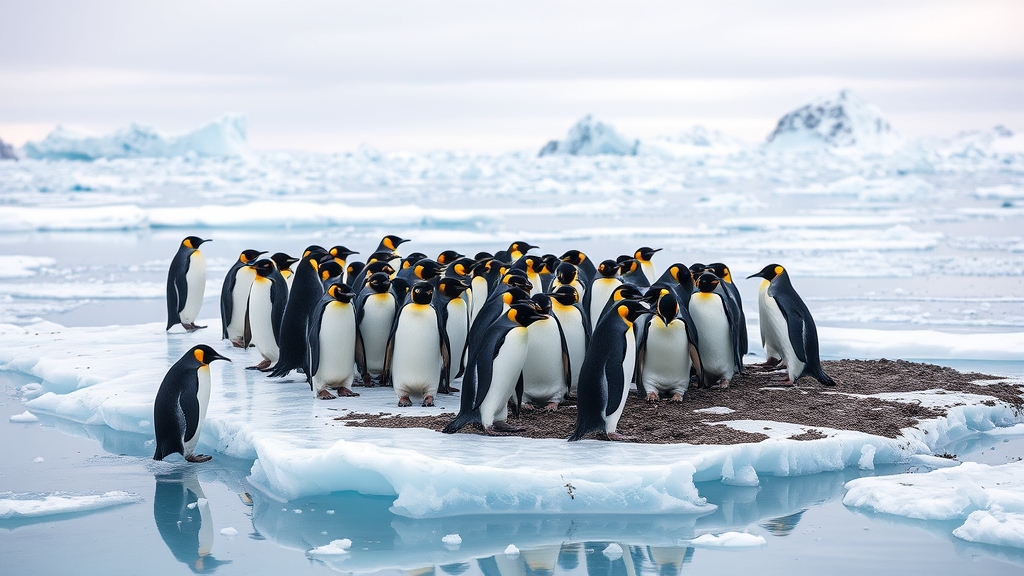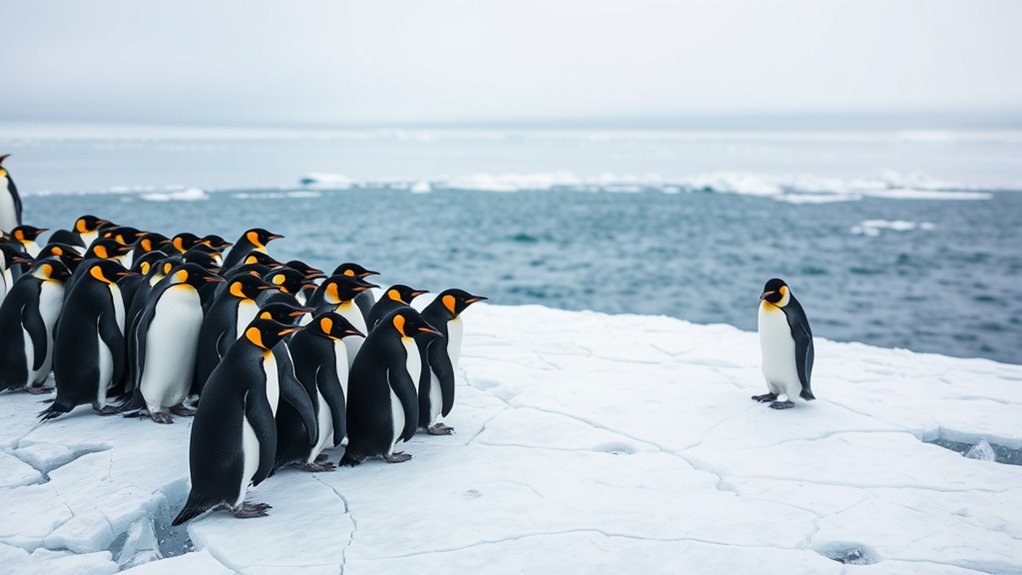As the Antarctic warms, penguins face challenges like melting ice, which reduces their breeding and foraging habitats. They must travel farther for food as prey populations shift, risking their survival. Efforts like protected areas, habitat restoration, and reducing emissions are helping, but depends on global action. To understand how penguins are adapting and what more can be done, keep exploring the impacts of climate change on their future.
Key Takeaways
- Climate change causes ice loss, shrinking penguin habitats and forcing longer foraging trips.
- Melting sea ice disrupts prey populations like krill, reducing food availability for penguins.
- Conservation efforts include protected areas, habitat restoration, and reducing greenhouse gas emissions.
- Monitoring populations and deploying artificial nesting sites support penguin breeding and resilience.
- Global cooperation and public awareness are vital for implementing policies to safeguard penguin populations.

Have you ever wondered why penguins are suddenly disappearing from their icy habitats? The answer lies in the alarming climate change effects impacting Antarctica and its surrounding regions. Rising global temperatures are melting ice sheets and glaciers at an unprecedented rate, shrinking the icy platforms that penguins rely on for breeding, resting, and foraging. As the ice diminishes, penguins are forced to travel farther for food, which reduces their survival chances and disrupts their breeding cycles. The changing climate also leads to shifts in prey populations, such as krill, which are a primary food source for many penguin species. When these prey sources become scarce or move to different areas, penguins struggle to find enough nourishment, further threatening their populations. Additionally, the loss of sea ice impacts the overall ecosystem balance, making adaptation even more challenging for these seabirds. Understanding the interconnectedness of these environmental changes is vital for designing effective conservation measures. Addressing these complex interactions requires a comprehensive approach to ecosystem resilience.
This rapid environmental change poses a significant challenge to penguin conservation. To counteract these impacts, conservation strategies are essential. Scientists and environmental organizations are working tirelessly to develop and implement effective measures to protect these iconic birds. One key approach involves establishing protected areas that safeguard critical breeding sites and feeding grounds from human interference and environmental degradation. These sanctuaries help maintain stable habitats, giving penguins a better chance to reproduce and feed successfully. Additionally, efforts to reduce greenhouse gas emissions are essential because climate change effects are driven largely by human activity. International cooperation to curb emissions can slow the rate of ice loss, giving penguins and other vulnerable species more time to adapt. Promoting climate change mitigation is therefore a crucial part of ensuring the survival of these resilient creatures.
On-the-ground conservation strategies also include monitoring penguin populations to gather data on their health and habitat conditions. This information guides targeted actions, such as habitat restoration or managing human activities like tourism and fishing that could disturb penguin colonies. Some organizations are even experimenting with artificial nesting sites to help penguins establish breeding grounds in areas less affected by climate change. Education campaigns raise awareness about the importance of safeguarding Antarctica’s fragile ecosystem, encouraging global support for policies that combat climate change and promote biodiversity. Protecting the Antarctic ecosystem is crucial for the survival of penguins and countless other species dependent on this unique environment.
Ultimately, the survival of penguins depends on our ability to implement effective conservation strategies that address climate change effects. You can play a part by supporting policies that reduce carbon footprints and by spreading awareness about the importance of safeguarding these resilient creatures. The future of penguins in Antarctica hinges on collective action—by understanding the challenges they face and working together, we can give these remarkable birds a fighting chance to endure in a warming world.
Frequently Asked Questions
How Do Penguins Communicate in Changing Antarctic Environments?
You might wonder how penguins communicate as their environment changes. They rely on vocal communication to connect with mates and colony members, even from a distance. Additionally, they use visual signaling like body postures and displays to convey aggression or courtship. As the environment alters, these methods help penguins maintain social bonds and coordinate activities, ensuring their survival despite the shifting Antarctic landscape.
What Role Do Penguins Play in the Antarctic Ecosystem?
You should know that penguins play a vital role in the Antarctic ecosystem by supporting the food web through their penguin breeding habits. They help control fish populations and serve as prey for larger predators. Your efforts in habitat preservation are essential, as protecting breeding sites guarantees their survival. By maintaining healthy penguin populations, you also help sustain the balance of this fragile environment.
Are Any Penguin Species Thriving Despite Climate Change?
You might wonder if any penguin species are thriving despite climate change. Some, like the Adélie and gentoo penguins, show signs of resilience due to their adaptability to changing conditions. Their climate resilience helps them find food and breeding sites, but not all species are so lucky. Penguin adaptability varies, and ongoing climate shifts threaten even the most resilient populations, making conservation efforts essential for their future.
How Do Penguins Find Food During Shifting Ice Conditions?
Picture penguins paddling through shifting, shimmering ice. You see how they adapt their foraging strategies to fluctuating prey availability. By diving deep and exploring new areas, they chase after fish, krill, and other tiny treats hiding beneath the melting ice. They respond swiftly to changing conditions, using keen senses and flexible tactics, ensuring they find food despite the unpredictable ice and prey patterns in their warming world.
What Conservation Efforts Are Most Effective for Penguins?
You can help protect penguins by supporting conservation efforts like establishing marine protected areas, which give their habitats a safe space to recover. Community engagement is also essential, as involving local communities raises awareness and encourages responsible behaviors. Together, these strategies preserve food sources and breeding grounds, ensuring penguins have a better chance to adapt and survive amidst climate change’s challenges. Your support makes a real difference.
Conclusion
As you witness the thawing of Antarctica, remember you’re holding the Earth’s fragile heartbeat in your hands. Penguins, like tiny ships steering turbulent seas, struggle to stay afloat amid rising temperatures. Their future depends on how we respond today. By acting now, you can help steer this icy world back toward calmer waters. The choice is yours—will you be the captain guiding these penguins through the storm or watch as their icy voyage melts away?






